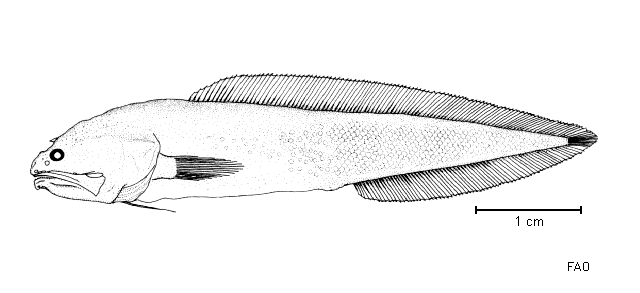| Bythitidae (Livebearing brotulas) |
| 9 cm SL (male/unsexed) |
|
benthopelagic; marine; depth range 146 - 850 m |
| Western Pacific: Arafura Sea to off New South Wales, Australia. |
|
Dorsal soft rays (total): 99-100; Anal soft rays: 64-65; Vertebrae: 57-58. This species is distinguished by the following characters: 2 spines on midline of head, one anteriorly directed on frontal above eye and another upward directed, weak and thin on ethmoid, 3 bony ridges on dorsum behind frontal spine; maximum width of head 5.6-6.0% SL, of body 3.5-3.9 % SL; elongated body with joined vertical fins; head naked, with anterior part of body having scattered scales in midline and posterior half almost fully scaled; skin thin and translucent; eye diameter less than snout-length; opercular spine covered by skin; posterior part of maxilla greatly expanded vertically; dentigerous bones with granular teeth; palatines in 2-3 rows; pectoral peduncle slightly longer than broad, not adnate; gill opening extending well above opercular spine; anterior gill arch with 3 long rakers; vertebrae, precaudal 15, total 57-58; D 99-100, A 64-65, pectoral 16-17, caudal 12; otolith length to height = 2.5, with sulcus undivided, placed in central part of inner face, and otolith length to sulcus length = 2.7 (Ref. 93007). |
| A viviparous, benthic species found on the lower continental shelf and slope (Ref. 75154, 93007). Rare species (Ref. 34024). A 5.7 cm SL female with full developed embryos (Ref. 34024). |
|
Data deficient (DD); Date assessed: 15 August 2019 Ref. (130435)
|
| harmless |
Source and more info: www.fishbase.org. For personal, classroom, and other internal use only. Not for publication.

